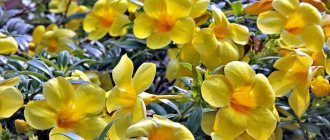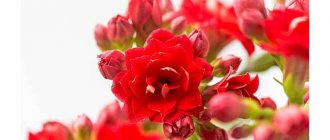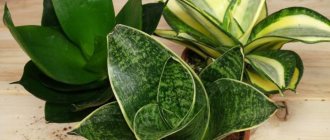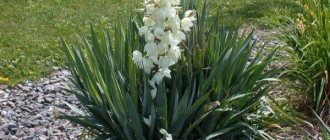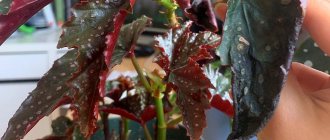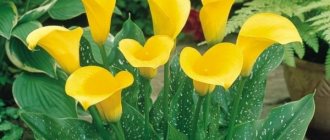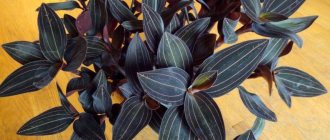Quarantine for new plants
Crassulas purchased from amateurs or in retail chains must first be placed separately from the main collection for 2 weeks in the following place:
- cool;
- shaded (but not dark);
- well ventilated.
Owners should monitor new plants for early signs of disease or pest infestation. Before selling, they are often washed off to get rid of external signs, but the problem remains.
Before sending it to a permanent place, the fat woman needs to be cured.
What to do if the fat woman is frozen
If the money tree is frozen, it immediately becomes noticeable by its appearance. The branches and leaves of a frozen plant become watery, begin to wither and gradually turn black. How to save a money tree if it is frozen:
- All frozen parts of the tree must be cut off immediately, sprinkling the wounds with charcoal or activated carbon powder;
- If the soil in the pot is frozen and there is a danger of the roots freezing, then the fat plant must be removed from the soil and the roots inspected. Damaged parts of the roots should be removed, after which the plant should be planted in fresh soil. Additionally, you can treat the tree with Epin's solution to give it new strength;
- If the upper parts of the fat plant remain intact, then cuttings can be cut from them for rooting and growing new healthy plants. The cut cuttings need to be dried a little in the air, and then planted in the ground. If cuttings cannot be taken, you can take a few intact leaves and grow new plants from them.
Money tree diseases
Physiological diseases associated with improper care at home require close attention. Infections are rare, if after purchase there were none on the fat plant, they also appear due to the negligence of the owners.
Functional diseases
They occur when normal life is disrupted under the influence of unfavorable factors or a sharp change in growing conditions. Sometimes, to cure a disease, it is enough to eliminate the source and provide proper care for the tree. If the situation becomes critical, the fat woman may die.
Rotten
Most often, the flower begins to hurt as a result of overwatering; the root is first affected, then the lower part of the trunk softens.
Gradually the disease spreads to the entire fat plant:
- vegetative organs become sluggish;
- darken;
- the main stem softens at the base;
- leaves fall off;
- the branches droop and lie on the edge of the pot;
- the plant dies.
A peat substrate or a substrate containing soil components in a container that is too spacious will turn sour. The fat woman cannot master the entire earthen lump; first it deteriorates along the edge, then in the root area. Organic matter decomposes, begins to smell bad, and sciarids (fungus gnats) appear. It is because of their distribution that careless owners often first pay attention to the problem.
The same thing happens if there is no drainage or bottom holes in the pot.
The cause of rotting of the leaves and stems of the fat plant is often caused by spraying the crown, especially at low temperatures. Then the decomposition process goes from top to bottom, and not vice versa.
Dropsy of leaves (edema)
Appears on the Crassula from increased watering, not necessarily abundant, wetting the lump completely. The problem also arises when the owners irrigate the substrate “a little bit,” but often. Poor lighting is often a contributing factor.
The disease is not accompanied by root rot, which is possible when growing Crassula in gravel, a well-drained soil or peat mixture containing a lot of raising agents. The substrate does not sour, since water does not linger there, aeration is excellent.
The lower, less often the upper, part of the leaf becomes pimply. The color remains green, but the bubbles may take on a grayish tint. The problem is caused by the death of part of the roots of the crassula. Since overwatering does not produce a fatal result due to the excellent permeability of the substrate, rotting did not spread to the entire root, but the consequences remained.
The affected plates will not recover. But they will not turn yellow, fall off, or dry out.
Leaf burn
The disease affects the fat woman:
- exposed to bright light without preparation;
- during morning spraying, when drops of water turn into lenses under the direct rays of the sun;
- if leaves touch hot window glass.
Due to a sudden change in lighting, the plates turn completely red. Areas exposed to high temperatures become whitish or dry, depressed, necrotic areas appear.
Frostbite
Crassula roots may be damaged if the pot is placed on a cold window in winter, especially after watering. Leaf tissues die when touching frozen glass.
Frostbite can be caused by an open window.
Infectious diseases
They appear extremely rarely on the Crassula. The introduction of pathogenic microorganisms is prevented by the strong immunity of the money tree and durable epidermis.
Where do they come from?
Viruses, bacteria and fungi enter the plant:
- together with garden soil - it is difficult to completely disinfect it at home;
- from the dirty hands of the owners;
- when working with non-sterile garden tools;
- spores are transferred to the Crassula by pets walking on the street;
- They fly in with the wind through an open window or vent.
Unsanitary conditions favor diseases, which in principle should not exist in the house.
What contributes to the spread
For the development of most infections, depending on the type:
- high temperature and humidity;
- some peak in the cool, but again, when there is a high concentration of water in the air or soil.
Typically, infectious diseases are accompanied by physiological ones, so it is difficult to determine them.
For normal caring for Crassula, the humidity should be low. Weakened plants with weak immunity and constantly under stress are most often affected.
Rare infections
Ordinary lovers of indoor flowers and experienced cactus growers who grow succulents at home and not in greenhouses rarely encounter infections on the crassula. But you need to know that the money tree can hurt:
- downy and true powdery mildew;
- septoria;
- black spotting;
- tracheomycosis.
Infectious root rots
A group of fungal diseases begins with damage to the underground part. Sometimes the plant dies without even having time to turn yellow and shed its leaves.
The reason for the appearance is a violation of agricultural technology:
- the owners bring contaminated soil from the garden;
- poorly processed or not even attempted to disinfect;
- they plant a fat plant in it;
- allow the substrate to become soaked.
The disease is caused by three genera of mushrooms, which can only get into the pot with garden soil:
- Pythium is from the group of oomycetes, which includes the blackleg. Lives in soil taken from nightshades, wheat, root crops, tobacco, and beans. Forms white fluffy spores. If seedlings are affected, it is useless to fight the disease.
- Rhizoctonia is a soil phytopathogenic fungus with felt-like mycelium. The spruce tree gets sick, the seedlings die, and the adult plants lie down.
- Late blight (Phytophthora). It gets into the house with soil from nightshade crops. The disease begins when the soil and air become waterlogged, coupled with sudden changes in temperature. On a money tree, the first manifestations are not the withering of the leaves, but the appearance of brown pimples that quickly increase in size.
What diseases do Crassula have, their treatment and photos
Most Crassula lesions are associated with fungal or bacterial-viral infections . Favorable factors for their appearance include cold and dampness in the room, excessive watering in winter. The following describes possible diseases of the fat woman and presents their photos.
What to do if the plant suffers from bacterial pathology?
Common diseases of succulents include:
Mosaic epiphyllum
Slightly in-depth, transparent, blurry yellow spots appear on the plant tissues. There is no treatment for the pathology; the flower must be destroyed .
Leaf yellowness
Causes a gradual change in leaf color to a yellowish color. The disease affects young shoots; during flowering, the buds dry out and fall off.
To preserve the succulent, it is necessary to excise all affected areas.
Tissue proliferation
Resembles cancerous tumors and is associated with attacks by pathogenic bacteria. Crassula can resist the disease for several years , continuing to grow and bloom, but after a while it will still die.
Important! Bacterial-viral diseases cannot be cured. The only way out is to remove the diseased plant from its healthy counterparts.
How to deal with a fungal disease of a flower?
Symptoms of diseases caused by fungal infection and further treatment depend on the type of pathogen.
Fusarium
It grabs the roots and gradually spreads to the green part along the conductive veins of the succulent. When cutting a leaf, the rusty tint of diseased tissue is clearly visible . Externally, the plant stops growing, the foliage and trunk become lethargic and turn pale.
Diseased areas are cut out with a sharp scalpel or knife, followed by treatment with a fungicide. Subsequently, the flower is kept in a dry room until the wound is completely healed. Crassula is transplanted after pre-treating the soil and pot with Fitolavin, Trichophyte or Fitomporin-M.
How to treat late blight?
Causes rotting of the root collar of the money tree and the subsequent spread of infection throughout all parts of the plant. It is manifested by the appearance of gray-brown spots on the green parts, rotten areas die off.
Damaged areas are cut off, the cut areas are sprinkled with charcoal powder or treated with a disinfectant solution. Measures will give results only in the first stages of the development of this disease ; in other cases, the succulent is disposed of.
Brown spot (anthocrosis)
Anthocrosis appears as round light spots deepened inside the leaf blade, or as a brownish spotted lesion that causes drying, hardness and crusting on the foliage.
Treatment is successful only at the beginning of the development of the disease; it involves excision of problem areas and sprinkling them with charcoal. The appearance of the flower is not restored.
Wet rot
It grabs the stem and spreads quickly - the plant can die in a few days . If the lesion is minor, the diseased tissue is removed, and the cut sites are treated with an antiseptic solution.
If discovered late, the succulent cannot be saved. The cause of wet rot is considered to be watering with cold water and waterlogging of the soil.
Dry rot
Dry areas appear on the stems, under which there are dried tissues. The disease cannot be treated; the money tree is destroyed. To prevent the spread of dry rot to the remaining flowers, the pot and window sill are disinfected and treated with fungicides one-time.
Important! Most fungal diseases can be successfully treated only at the beginning of their development. In other cases, getting rid of Crassula is the only way not to lose all the other house plants.
Crassula pests
Larvae and adult insects on a money tree are easy to detect if the owners inspect it regularly. Pests appear infrequently, since it is difficult to bite through the covers of a healthy flower.
There is information that the fat plant can be affected by aphids, but it was not possible to find even a photo on the Internet. The pest is unlikely to pierce the epidermis if the tree has not lost so much turgor that the leaves become like rags.
Spider mite
This is not an insect, but an arachnid. Loves dry air and high temperatures, drinks Crassula cell juice. It is difficult to see the pest with the naked eye, but the results of its vital activity are clearly visible:
- thin web;
- a coating similar to coarse dust on the back of the sheet;
- straw-colored pinpoint punctures at the bite sites;
- with a strong spread of the pest, the entire plate of the fat plant turns yellow unevenly;
- Over time, the leaves become thinner and fall off.
Shchitovka
A sedentary pest, difficult to destroy due to the waxy coating covering the shell. It looks like an oblong growth or plaque, tightly clinging to a vegetative organ. To remove scale insects mechanically, the pest has to be scraped off.
The color blends in with the plant or is dark. Lives in colonies. Draws out intercellular fluid from the fatty acid.
Mealybug
It is clearly visible, settles in the axils of leaves, sucks juices from vegetative organs. The clutches look like lumps of cotton wool made of waxy white threads. The body is oblong, as if sprinkled with flour; thin legs are visible on the sides.
More mobile than the scale insect. It has soft covers, which makes it easier to fight the scale insects.
Thrips
An insect with an elongated dark body up to 2 mm, the mouthparts are of the piercing-sucking type. The pest flies poorly, but runs well.
Settles from the underside of leaves. The bite sites are initially straw-colored or watery, then merge into brown spots. The affected plates fall off over time.
Nematode
A dangerous pest, fighting it rarely ends in success. At the slightest suspicion, it is recommended to get rid of the fat plant and the pot of soil.
May affect the underground part or shoots:
- in the first case, in order to detect the pest, you need to examine the root - it will be covered with galls (growths);
- stem nematode causes deformation of the plates and cracking of the shoots.
Why do the leaves become limp and fall off?
In addition to the main reasons for the loss of leaves on the money tree described above, there are several more that are directly related to the characteristics of caring for the plant at different times of the year.
In summer, the money tree must be protected from the scorching sun, drying out of the soil and too dry air, drafts and overheating of the substrate in the pot. It should be watered daily, moderately, in the evening, removing excess moisture from the pan.
In the fall, it is important to bring the money tree indoors in time. Night cold temperatures below 10ºC can cause hypothermia of the root system, which can cause disease or stress
In winter, you should not place a money tree near heating appliances. In the short days of late autumn and until mid-winter, the plant needs additional lighting. The optimal length of daylight for a money tree is 10-12 hours; based on this condition, it is provided with additional lighting.
Another winter problem is dry indoor air. Although the fat woman is indifferent to humidity, once a month she will benefit from a small warm shower.
There are a number of other problems that lead to the leaves of the fat plant falling off, but they relate to the plant’s habitat.
Money tree is an energetically powerful plant. It is strongly connected with its owners, often falling ill with them. Therefore, it often happens that the tree begins to wither if one of the household becomes seriously ill.
If the money tree is kept under normal conditions and its care is carried out “according to the textbook,” experienced flower growers advise paying the owners’ attention to their own health. Often, exacerbations of chronic diseases of family members have a negative impact on the plant: it grows poorly, the leaves wither and fall off
Here it is not the plant that needs to be treated, but people. With the recovery of the owners, the money tree quickly comes to its senses
Often, exacerbations of chronic diseases of family members have a negative impact on the plant: it grows poorly, the leaves wither and fall off. Here it is not the plant that needs to be treated, but people. With the recovery of the owners, the money tree quickly comes to its senses.
Also, the energetic connection between the fat woman and family members is clearly expressed when conflict situations arise. If quarrels, scandals, and conflict situations often occur in the house, the money tree, like a tender young lady, begins to mope, expressing its protest by dropping leaves. And in this case, it is not the plant that needs help, but people. When home calm and peace are restored, the tree will also be restored.
Prevention measures
Diseases and pests will not be dangerous for the money tree if preventive measures are carried out in a timely manner:
- water frequently, but in small portions in the summer and reduce watering to a minimum in the winter;
- Apply fertilizing according to the instructions using the root method;
- carry out regular inspection of the plant;
- periodically bathe the money tree in the shower;
- monitor the dryness of the air, organize humidity within 50–70%.
If pests or disease are detected, the plant must be quarantined, moving it away from other indoor flowers or moving it to another room until it is completely cured.
Transfer
The money tree does not need to be replanted annually. Moreover, it is better to avoid it unless absolutely necessary. Since the root system of the fat plant is sparse, damage to the delicate roots will be painful for it. Replanting is done as the plant grows, changing the bowl to a wider one. If the Crassula is too large, then remove the top layer of soil and replace it with fresh substrate.
Transplantation is carried out only if it is necessary to change the bowl or treat the plant
Air humidity
Dry air is the common habitat for the fat woman, so it tolerates heating in winter without problems. And in the summer, many people put it on the balcony or open veranda. You just need to make sure that the plant is not exposed to heavy rain. In order to wash off dust from the leaves, place Crassula under a small shower, covering the soil from moisture. The procedure can be repeated no more than once a month.
Crassula does not need to be sprayed. This will only harm the plant, which already stores enough moisture. Otherwise, the Crassula will begin to hurt and shed its leaves.
Mistakes in caring for Crassula
The most common mistake is improper watering. It is the excess or lack of moisture that entails a lot of problems.
Over- or under-watering
Most amateur gardeners rarely pay attention to the origin of a particular plant, but at the same time try to create comfortable conditions for it. Crassula belongs to succulents - plants that are accustomed to storing moisture for a long period, so you only need to water Crassula so that it once again accumulates moisture in the trunk and leaves. In summer this should be done once a week, in winter no more than once a month. Excessive watering threatens Crassula with rotting of the roots and stems, fungal diseases, falling leaves, impaired growth and development, up to complete death.
Insufficient watering and excessive drying of the earthen clod are also dangerous for the fat plant: the leaves will begin to turn yellow and fall off, and the roots will dry out. Having noticed all these signs, it is necessary to urgently adjust watering, carrying it out when the top layer of soil has completely dried out. The money tree should be watered exclusively with settled water at room temperature, avoiding overcooling of the root system.
Incorrect lighting
Crassula loves well-lit areas and does not tolerate shading. With a lack of light, the money tree will stretch, the trunk will become thin and will not be able to support the heavy crown. Direct sunlight at lunchtime is dangerous for the fat plant: its leaves can get burned, which is manifested by the appearance of brown spots. From 11 a.m. to 4 p.m., it is recommended to shade the window with a curtain. In summer, Crassula feels great on the open veranda, in winter on the southern windowsill.
Uncomfortable temperature
It should be noted that the fat woman tolerates both high and low temperatures well. The fact is that cold, together with high humidity and excessive watering, is likely to cause fungal diseases, and high temperature with insufficient moisture will cause the plant to dry out or die of its individual parts. It is better to keep the money tree at a comfortable temperature - 15°C in winter and 25°C in summer. A deviation of 2–3°C in one direction or another is allowed.
Unsuitable soil
Crassula still belongs to relatively unpretentious plants. If the soil in which it has to develop is dense and heavy, the Crassula will stop growing or die altogether. The substrate should be light and airy and not interfere with moisture absorption and air circulation. It happens that when watering, the water does not go deep into the bowl. This means it's time to change the top layer of soil, otherwise the leaves of the money tree will begin to turn yellow, dry out and fall off. You should not overuse loosening, since the roots of the money tree are superficial, thin, and easy to injure.
Fertilizer
Sometimes improper use of fertilizers can lead to damage to plants. The leaves of the crassula will begin to wrinkle, acquire a purple tint, dry out and fall off. A lack of nutrients also has consequences: the money tree will stop growing, natural physiological processes may be disrupted, and green pimples will appear on the leaves.
